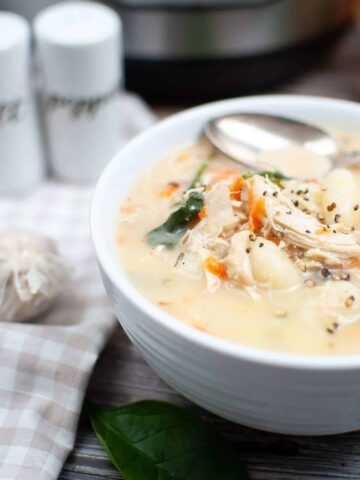The Instant Pot has become a popular kitchen appliance due to the convenience and versatility it offers. It's a pressure cooker that can also be used for slow cooking, sautéing, and even making yogurt. However, one of the most common questions about using the Instant Pot is how full can you fill it? In this article, we'll explore the benefits of using an Instant Pot, the capacity of your Instant Pot, understanding the maximum fill line, tips for avoiding overfilling, the impact of overfilling, adjusting cooking times, batch cooking, maximizing your Instant Pot, and cleaning and maintenance tips for after a full Instant Pot.
The Benefits of Using an Instant Pot
The Instant Pot is a time-saving appliance that can be used for a variety of cooking methods. It's perfect for busy individuals or families who want to prepare healthy meals quickly. The Instant Pot uses high pressure to cook food faster than traditional methods. Additionally, it can also be used for slow cooking and other functions as well. Another benefit of using an Instant Pot is that it can cook large quantities of food, meaning that meal prep can be done for the week ahead.
Furthermore, the Instant Pot is a versatile appliance that can be used to cook a wide range of dishes, from soups and stews to rice and even desserts. It also has a variety of settings that allow for precise cooking, such as a sauté function for browning meat or vegetables before pressure cooking. The Instant Pot is also easy to clean, with a removable inner pot that can be washed in the dishwasher. Overall, the Instant Pot is a valuable addition to any kitchen, making meal preparation faster, easier, and more convenient.
Understanding the Capacity of Your Instant Pot
Instant Pots come in various sizes, such as 3-quart, 6-quart, and 8-quart. The size of the Instant Pot you have will determine its capacity. It's important to not overfill the pot, as this can cause issues during cooking. So, how full can you fill the Instant Pot?
The general rule of thumb is to not fill the Instant Pot more than two-thirds full. This is because the Instant Pot needs space to build pressure and create steam, which is what cooks the food. Overfilling the pot can result in the food not cooking properly or even burning.
It's also important to note that certain foods, such as rice and beans, expand during cooking. So, if you're cooking these types of foods, it's best to fill the Instant Pot even less than two-thirds full to avoid any potential issues.
The Maximum Fill Line: What it Means and Why it Matters
The Instant Pot has a maximum fill line located in the inner bowl of the pot. This fill line is there for a reason. It indicates the maximum amount of food and liquid the Instant Pot can handle. Filling the Instant Pot over the maximum fill line can cause food to overflow and ruin your dish. Additionally, if you're working with foods that expand during cooking, such as rice or pasta, filling the Instant Pot over the maximum fill line can cause these foods to clog the pressure release valve and increase the risk of a safety hazard.
It's important to note that the maximum fill line can vary depending on the size and model of your Instant Pot. Always refer to the user manual for specific guidelines on the maximum fill line for your particular Instant Pot. It's also important to remember that the maximum fill line applies to both liquid and solid ingredients. Even if you're not adding any additional liquid to your recipe, you still need to be mindful of the maximum fill line when adding solid ingredients.
One way to ensure you don't exceed the maximum fill line is to use the "pot-in-pot" method. This involves placing a smaller container inside the Instant Pot and cooking your food in that container. This method is particularly useful when cooking foods that expand during cooking, as it allows for more space and prevents clogging of the pressure release valve. Just make sure the smaller container you're using is safe for use in the Instant Pot and can withstand the pressure and heat of the cooking process.
Avoiding Overfilling: Tips and Tricks for Measuring Ingredients Accurately
The key to avoiding overfilling your Instant Pot is to measure ingredients accurately. This means using measuring cups and spoons for liquids and dry ingredients. It's also important to not overcrowd the Instant Pot with food. Leave some space in the inner bowl to prevent food from overflowing. Finally, follow recipes and cooking instructions carefully. Professionals who use an Instant Pot frequently can give invaluable advice and tips.
Another important tip for measuring ingredients accurately is to use a kitchen scale. This is especially helpful for ingredients like flour, which can be easily compacted and result in inaccurate measurements. A kitchen scale allows you to measure ingredients by weight, ensuring precision in your cooking.
It's also important to consider the temperature of your ingredients when measuring. For example, if a recipe calls for room temperature butter, make sure to let the butter sit out for a while before measuring. Using cold or melted butter can result in different measurements and affect the outcome of your dish.
The Impact of Overfilling on Cooking Time and Results
As previously mentioned, overfilling the Instant Pot can cause food to overflow. But it can also affect the cooking time and results of your dish. If there's not enough space in the inner bowl, the food doesn't cook evenly, leading to some parts being undercooked and others overcooked. This can also affect the texture and taste of your dish.
Furthermore, overfilling can also increase the pressure inside the Instant Pot, which can result in longer cooking times. This is because the pressure needs to build up to the required level before the cooking process can begin. This can be especially problematic if you're cooking time-sensitive ingredients, such as vegetables or seafood, which can quickly become overcooked and lose their flavor and texture.Another issue with overfilling is that it can make it difficult to properly season your dish. When there's too much food in the Instant Pot, it can be challenging to evenly distribute the spices and seasonings throughout the dish. This can result in some parts of the dish being bland, while others are overly seasoned. To avoid this, it's important to leave enough space in the inner bowl to properly mix and season your ingredients.
How to Adjust Cooking Times for Different Levels of Fullness
When it comes to cooking times, the Instant Pot will adjust automatically based on how full the inner bowl is. The cooking time remains the same whether you're using a 3-quart, 6-quart, or 8-quart Instant Pot; the only difference is the amount of ingredients you can fit inside the pot.
However, it's important to note that the type of food being cooked can also affect the cooking time. For example, if you're cooking a large piece of meat, such as a roast, it may take longer to cook than if you were cooking a smaller cut of meat or vegetables. It's always a good idea to consult a recipe or cooking chart to ensure that you're adjusting the cooking time correctly based on the level of fullness and type of food being cooked.
Using the Instant Pot for Batch Cooking: How Much Can You Cook at Once?
The Instant Pot is great for batch cooking, but it's important to know how much you can cook at once. Typically, you can fill the Instant Pot to about ⅔ full, leaving some space for food to expand and release steam. The amount you can cook will depend on the size of your Instant Pot.
It's also important to consider the type of food you're cooking when determining how much you can fit in the Instant Pot. Foods that expand, such as rice and beans, will take up more space than denser foods like meat or vegetables. Additionally, if you're cooking a recipe that requires stirring or adding ingredients mid-cooking, you may need to leave even more space in the Instant Pot to avoid overflowing or splattering.
Maximizing the Potential of Your Instant Pot by Filling It Correctly
The key to maximizing the potential of your Instant Pot is to fill it correctly. Always measure ingredients accurately and never overfill the inner bowl past the maximum fill line. This will ensure consistent and even cooking results every time.
Cleaning and Maintenance Tips for Your Instant Pot After Filling It to Capacity
After using your Instant Pot to its full capacity, it's important to clean it properly. Start by unplugging the Instant Pot and allowing it to cool down. Next, remove the inner bowl and wash it with soap and water. Be sure to clean the lid, silicone ring, and steam release valve. Additionally, periodically check the valve and silicone ring to make sure they're functioning properly.
Conclusion
In conclusion, the Instant Pot is a versatile and efficient kitchen appliance. It's important to not overfill the pot past the maximum fill line to avoid issues during cooking. Measuring ingredients accurately and following recipes and cooking instructions carefully will give you consistent and delicious results every time. With proper care and maintenance, your Instant Pot can last for many years, making meal prep and cooking easier than ever before.




Leave a Reply